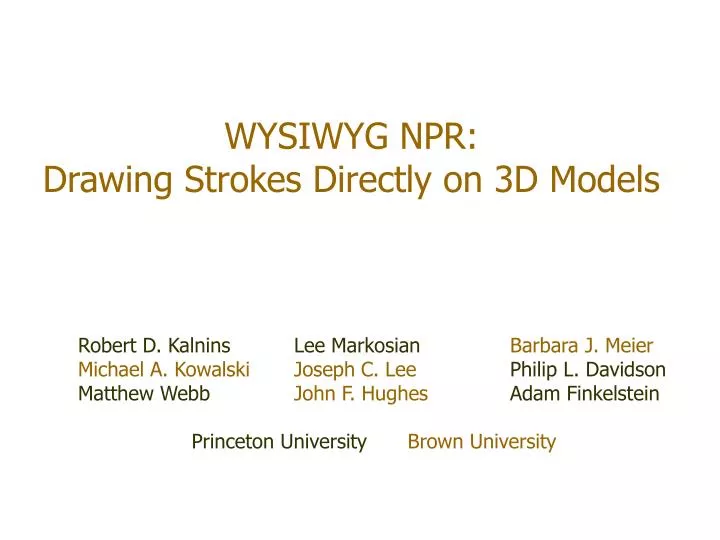drawing strokes directly on 3d models
![]() Download
Download

Skip this Video
Loading SlideShow in 5 Seconds..
WYSIWYG NPR: Cartoon Strokes Direct on 3D Models PowerPoint Presentation


WYSIWYG NPR: Drawing Strokes Directly on 3D Models
Download Presentation
WYSIWYG NPR: Cartoon Strokes Directly on 3D Models
- - - - - - - - - - - - - - - - - - - - - - - - - - - E North D - - - - - - - - - - - - - - - - - - - - - - - - - - -
Presentation Transcript
-
WYSIWYG NPR:Drawing Strokes Direct on 3D Models Robert D. Kalnins Lee Markosian Barbara J. Meier Michael A. Kowalski Joseph C. Lee Philip L. Davidson Matthew Webb John F. Hughes Adam Finkelstein Princeton University Brown University
-
Outline • Related Piece of work • Introduction • Objective • An Instance • Paper • Toon Shaders • Stroke • Silleuette • Hatching • Results
-
Markosian et al. 1997 Salisbury et al. 1997 Deussen & Strothotte 2000 Meier 1996 Related Work one/2 • NPR approaches • Producing still images
-
Markosian et al. 2000 Praun et al. 2001 Related Work 2/2 • NPR approaches • Producing withal images • Interactive rendering (with temporal coherency)
-
Introduction • Directly WYSIWYG painting [Hanrahan & Haeberli 1990] • Directly painting texture maps onto 3D models
-
billboard bridge ground strokes terrain editing Introduction • Providing direct cartoon interfaces for creating stylized scenes [Cohen et al. 2000]
-
Objective • A system that Provides direct drawing interfaces for creating stylized scenes • Starting with a 3D model, and • Drawing directly on it
-
Loading a model. Displaying the model in a silhouette style. An Example
-
Choosing a toon shader. Creating background color and texture. Adjusting the lighting. An Example
-
Choosing a castor. (black pencil) Selecting silhouette style. Cartoon creases. An Example
-
Calculation a label by cartoon decal strokes. An Example
-
Drawing hatching. An Example
-
Choosing a toon shader. Creating background color and texture. Adjusting the lighting. Where we are…
-
Newspaper ane/2 • Background color or image
-
at h = 1, t(a) = clamp(2a) at h (0, 1), t(a) = h clamp(2a) + (ane – h) clamp(2a – 1) at h = 0, t(a) = clamp(2a - 1) Paper 2/2 • Media simulation for a paper effect • Paper texture encoding a height field, h [0, 1] • Compositing incoming color into the framebuffer with transparency t(a)
-
Generating texture coordinates from L . due north Toon Shaders • Cartoon each patch of the object • Using custom 1D texture maps [Lake et al. 2000]
-
Toon Shaders with Media Simulation • Rendered over a coarse paper texture
-
Where We Are… Pucker strokes Decal strokes Silhouettes
-
Strokes 1/two • Stroke primitive • [Northrup and Markosian 2000] • Represented every bit a Catmull-Rom spline • Elements under user control: • Color • Alpha • Width • Caste of taper at endpoints • "halo"
-
Strokes 2/2 • Visibility • Using an ID reference image: [Northrup and Markosian 2000] rendering mesh faces, pucker edges, silhouette polylines – each in a unique color
-
this piece of work [Hanrahan & Haeberli 1990] Decal Strokes • For cartoon direct onto a surface • Represented equally spline curves • Benefits: • No necessity for a parameterization of the surface. • No sampling artifacts • Consequent screen-infinite width of strokes
-
Crease Strokes • Creases: • Chains of mesh edges following abrupt features • When a crease is oversketched, … • Recorded as a crease path + a set of displacements Base Path
-
Stylized Strokes • Rubber Stamping • Repeating a sequence of example offsets • Synthesizing past case • Adopting 'video texture' to generate less repetitive offsets [Schödlet al. 2000]
-
Silhouettes 1/4 • Applying a sketched image stroke to all silhouettes • Issues: • Silhouette detection • Temporal coherency
-
nv nv v v cv cv f(v) = nv. cv Silhouettes 2/iv • Silhouette detection: • Checking randomly sampled faces • Tracing neighboring triangles containing any silhouette
-
Silhouettes 3/four • Temporal coherency • Silhouettes are view-dependent
-
Silhouettes 3/4 • Temporal coherency • Using arc-length parameter of the previous frame
-
Silhouettes 4/4 • Scaling • Scaling magnitude of the offsets • Simply when zoomed out
-
Where We Are… Hatching
-
Hatching • Structured hatching • A group of roughly parallel strokes • Automatic LOD control User specified strokes Starting time transition
-
Hatching • Free hatching • Edifice LODs explicitly by the artist
-
Hatching • Mobile hatching • Hatching moving on the surface ex) the shade and the highlight
-
a mobile hatching group Hatching • Mobile hatching • Inferring light management • Assume "diffuse highlights" or "nighttime lite" • How… • 1. Projects the strokes into uv-space • 2. Computes their convex hull • 3. Finds its centroid c and records the normal nc nc c v u
-
northward(u) a mobile hatching grouping T Hatching • Mobile hatching • Creating a mobile hatching grouping at each local maximum in l(u) • Using a threshold T • T=1/2 • Avoiding popping effect • Fade out as l(u) approaches T fifty(u) = nc.n(u) c v u
-
Results • Environment: • 1.5GHz Pentium IV CPU / GeForce3 GPU
-
Results
-
Determination and Future Work • A system for drawing stroke-based NPR styles directly on 3D models • Extending to • Styles such equally stippling and pointilism • Object-to-object interactions
Source: https://www.slideserve.com/andrew/t-s-gwon
0 Response to "drawing strokes directly on 3d models"
Postar um comentário